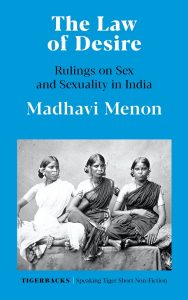
Can a woman choose whom to marry if her father disapproves of the match? Does sex remain sex when it becomes work? Can a man become a woman because he feels like one? Is it the law’s task to ensure heterosexuality? Does reproduction need to be regulated?
The State attempts, with law as its instrument, to answer these questions for us, through legislation and, when contested, through court judgments. This brilliantly insightful and superbly argued book calls into serious question the wisdom—indeed, the intent—of our lawmakers and the judiciary. Though India’s laws and courts claim to know what they mean when they declare an expression of desire immoral or criminal, obscene or unnatural, upon inquiry, they turn out to be building on very weak and often casteist and patriarchal assumptions.
Teacher and queer theorist Madhavi Menon—author of Infinite Variety, a celebrated study of desire in India—shows us the ‘conundrums and paradoxes’ that result when the law is entangled with sex and sexuality—and why we ‘need to play with, rather than stay with, the Law of Desire’.
Read an excerpt from the book.

Can a woman choose whom to marry if her father disapproves of the match? Does sex remain sex when it becomes work? Can a man become a woman because he feels like one? Is it the law’s task to ensure heterosexuality? Does reproduction need to be regulated? These are some of the many questions with which the law is faced, and upon which it pronounces.
Ranging from deliberations over Bills to the passage of Acts, from hearings in the lower courts to appeals in the Supreme Court, from cases under British rule to those post Independence, the law has been deeply entangled with desire. But how, and with what assumptions, are legal pronouncements on desire made? How does the law appear when looked at from the vantage point of desire? What are the consequences of specific laws on the texture of desire?
The recent judgment in Mobashar Jawed Akbar vs Priya Ramani(2021) makes clear the multiple assumptions about desire that go into a legal verdict. In February 2021, Justice Pandey cleared a journalist on charges of defamation for publishing an account of sexual harassment. By ruling that women can and should speak publicly about incidents of sexual harassment,the Court sent a clear signal that we must not tolerate unwanted sexual attention. In noting that public posts can legally be classified as being for the public good, the Court made the question of sexual harassment a question of the public domain itself. And by arguing that social status does not provide behavioural impunity, the Court recognized that sexual predators can lurk behind even seemingly respectable facades. All this is to the good.
But despite its social concern, the judgment is also sexually dubious. Or more precisely, its attitude to desire is cause for some concern. Justice Pandey’s judgment is a response, he says, to the sexual shame that women feel when they are subjected to harassment. In order to counter ‘The Shame’, the learned judge suggests a turn to the epics of the Mahabharata and Ramayana to uncover historical instances of ‘respect for women’. It is startling that the judgment adduces ‘respect for women’ as one of the themes of the Ramayana, even though Sita is shunned in the text for being the bearer of ‘The Shame’.
This is also the text in which Sita is made to go through a trial by fire in order to prove her sexual virtue. And it is also the text in which, despite passing the trial by fire, Sita is shunned because her demonstrated virtue cannot quell the paranoid fantasies of the citizenry around her.
Undeterred by these facts, the judge goes on. As an example of ‘respect for women’ he cites the Valmiki Ramayana’s account of Laxman being asked to describe what Sita looks like. Laxman responds to the question by saying he does not know what she looks like because he has never looked at her beyond her feet. The judgment holds this up as an example of respect for women. But what this tale from the Ramayana suggests is a phobia of women. Laxman does not look beyond Sita’s feet because she is married to his brother, and is therefore owned by another man. He draws a circle around Sita to keep her desires within patriarchal control, and warns her not to step outside its ambit. When she does, Sita is punished for transgressing against male control. In other words, the tale of Sita from the Ramayana is a glaring example of a moral regime in which women’s desires cannot be trusted because they lead to disaster for men. Women must be protected from their desires in order for men to preserve the status quo. This sexual morality polices desire without preventing its abuse, and signals an official recognition of women as men’s property. As we see in the Akbar vs Ramani case, even a celebrated judgment on sexual harassment operates within this dubious terrain of sexual conservatism. And it also dabbles in religious majoritarianism by harking back to the Ramayana, especially in a case involving a Muslim man.
Picking ‘desire’ as the term with which to represent these many facets of sexuality, politics and culture might seem like an odd choice, particularly since the law itself rarely uses the word. But ‘desire’ is also the term that can most fully evoke these multiple affective and historical registers without being reducible to any one of them.
Desire conjures up sexual acts and orientations while also not being synonymous with them. It points to embodied genders and enacted sexualities while also including social aspirations and legal standards. Desire can straddle the body, mind, social structures and cultures at large.
Desire suggests pleasure while also encompassing pain.
Like its subject matter, ‘desire’ is immense. This is why we have so many laws to deal with it.
But these laws do not simply thwart desire—they also enable it. Law promises official recognition if desire can be reduced from multiplicity to a specific category of identity. For instance, law confers rights based on specified gender and sexual orientations—you are rewarded for being heterosexual and for marrying within your caste, religion, and community. If you do not abide by the constraints of hetero-sex, binary gender, and caste and religious endogamy, then you are punished with administrative burdens; even when law allows people to define their desires as non-binary and non-heterosexual, it upholds a social norm that makes it difficult for people to act on those desires. Homosexuality, for instance, is no longer criminalized in India. But it has to act within the normatively legal structure of privacy in order to assure itself of State protection. Being legally recognized also means being legally policed.
Another way in which the law enables desire is more perverse, and therefore, more fascinating. By putting obstacles in the way of desire, law ensures its flourishing multiplication. Think of all our most famous love stories: Heer-Ranjha, Layla-Majnun, Romeo- Juliet. They all have in common lovers in opposition to an unfriendly law; indeed, in Nizami’s twelfth-century Persian rendition of Layla-Majnun, the poet notes that Majnun ‘was a lover, and love knows no laws’. Desire in these stories increases not only despite the obstacles put in their way by family and social pressure, but also because of them. The law inadvertently encourages the militant, unruly, and threatening aspects of desire to emerge in full force—literature and history are full of such examples.
This is why law wants desire to be categorized because desire poses the biggest threat to the rule of law. By sneaking past social constraints of caste and religion and gender and orientation, desire threatens to unravel the social fabric itself. Law wants to maintain the status quo, while desire can overturn hierarchies. The law protects social structure, while desire threatens to undo it. Even the simplest possible question posed from the vantage point of desire has the ability to upset social categorization. For instance, the progressive NALSA legislation in 2018 on the category of the ‘third gender’in India confers civic rights on third gender people. But the law cannot bring itself to ask why gender should be tied to civic rights that are due to any citizen of the country. Why does the law need to know if I am a man or a woman or neither or both in order for me to get a ration card? What is the relation between my gender and how much subsidized rice I can buy? This is precisely the line of thought the law disallows because it questions fundamental categorical assumptions.
But there is hope yet. Despite the law’s delight in definition, it is riddled with caveats and exceptions. It is not enforceable in any uniform manner, and petitions can result in drastically different judgments. The law is thus less rigid than it pretends to be because its fundamental activity is that of ‘interpretation’. Equally, desire is often more acquiescent than we might like it to be. Under pressure, it disavows multiplicity in order to inhabit straitjacketed categories sanctioned by the State.
Desire can thus appear to be legally dutiful despite its unruliness, while the law can in fact be more chaotic than the rigidity of its demeanour.
Excerpted from The Law of Desire: Rulings on Sex and Sexuality in India by Madhavi Menon. Published by Speaking Tiger Books, 2021.
Madhavi Menon is professor of English at Ashoka University, and writes on desire and queer theory. She is the author of Wanton Words: Rhetoric and Sexuality in English Renaissance Drama; Unhistorical Shakespeare: Queer Theory in Shakespearean Literature and Film; and Indifference to Difference: On Queer Universalism. She is also the editor of Shakesqueer: A Queer Companion to the Complete Works of Shakespeare.
Source- Indian Cultural Forum, March 3, 2022.



